THE REAL 1980s SHOCK TROOPS OF THE SOVIET ARMY

When Battlefront published WORLD WAR III TEAM YANKEE SOVIETS https://www.flamesofwar.com/hobby.aspx?art_id=7154 four years ago, they introduced Soviet units with NATO capabilities – the Shock T80 company. The backstory was that one of the regiments of 4th Guards Tank Division was permitted to experiment with Western-style tactics. The regiment created a special ‘shock’ battalion pairing shock tank companies with shock motor rifle companies.
Some consider the story inflated or perhaps fantasy. The truth is the Soviets had units that trained beyond the NORMs for motor rifle and tank formations and some that mimicked NATO tactics. The problem is that they weren’t equipped with T80s or BMP-3s.
This is their story, and PART II will be discussion of how to represent these units in casual gaming.
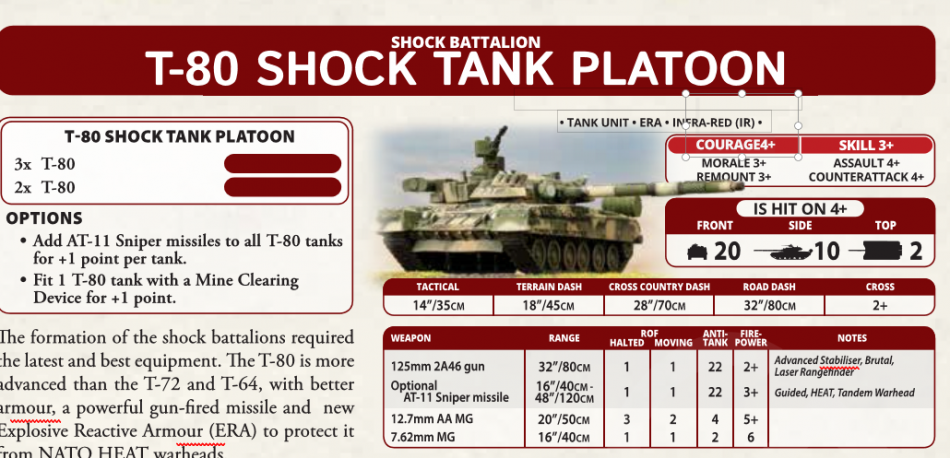
Independent Regiments for Border Screening
Soviet troops patrolled the Inner German Border (IGB) from 1946. When the East Germans established their own military, they quickly established their own border troops – the Grenztruppen. These were lightly armed paramilitary police units. While effective at patrolling the border, they offered no security against a NATO attempt to forcibly reunify Germany. The Soviets backed these troops up with tank battalions augmented with their own infantry. These were called border screening troops, and distinct from KGB units. Their purpose was to protect the Soviet (and later Volksarmee) units deploying from garrison.
After Khrushchev ended the Soviet heavy tank family, STAVKA had the problem of repurposing heavy tank organizations. Many retained their original identities, even as they were re-equipped with Standard Tanks (the Soviet name for what the West called Main Battle Tanks or MBT). However several became parent HQ for collections of border screening units.
Some heavy tank battalions were fed into the screening organizations or used to give independent tank battalions to motor rifle divisions in the Group of Soviet Forces Germany (GSFG), Central Group of Forces (CGF) and others. By 1980 this process was complete, leaving GSFG with seven Independent Tank regiments for Border Screening. 5th Independent Tank Brigade’s conversion into the 138th Independent Tank Regiment ended the process.
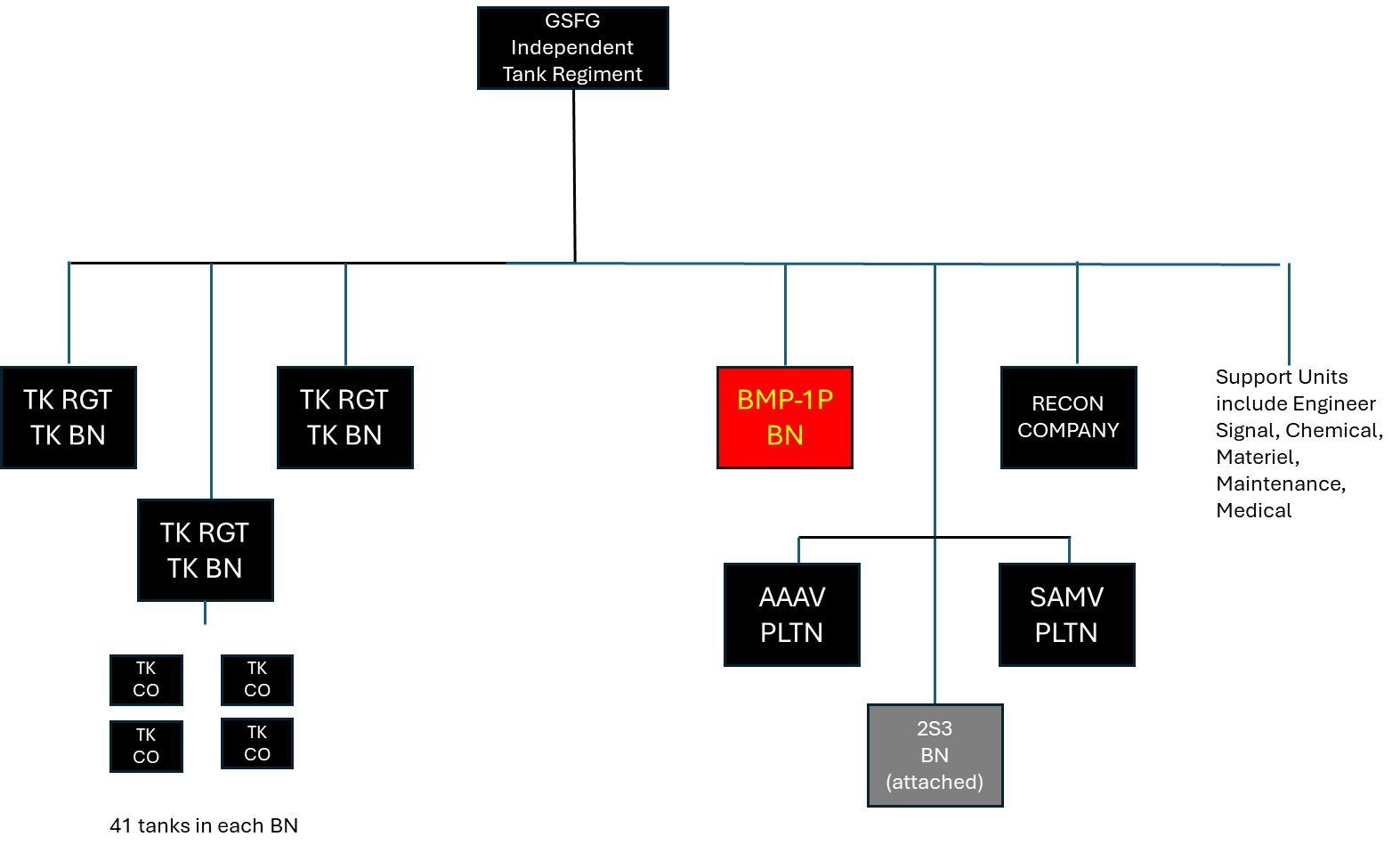
These new regiments initially retained their old tanks until fielding of the T64 made T62s available. When T62s were withdrawn, they were re-equipped with T64As upgraded in East German workshops to T64B armor standards. According to ex-Soviet tankers corresponding on TANKNET, the T64s were in place by 1983.
These units’ peacetime function was providing collective training for other Soviet units in their area. They were encouraged to adopt Western style tactics, so that the beneficiaries of their attention became familiar with how NATO forces would respond. While not as sophisticated as the National Training Center experience, it was different than the typical Soviet exercise.
The incidental effect was these units were better trained than the typical Soviet unit, and able to copy NATO tactics. Put differently, they were virtually a match for BF’s description of ‘shock’ units.
In wartime, the role of the border screening regiments mirrored NATO’s covering forces with one significant difference – in short notice scenarios these regiments were expected to roar across the border and screen it from 20-30 kilometers deep in NATO territory, preventing NATO artillery from shelling border crossing points.

The organization differed from the standard tank regiment. Each battalion had FOUR companies with a total of 41 tanks each, giving the regiment 124 tanks. The regiment had a full BMP battalion with 45 BMPs (BMP-1P after 1983). Some sources claim the reconnaissance company had an extra tracked recon platoon. One oddity was the absence of an artillery battalion.
To keep Western intelligence guessing about the wartime purpose of these units, the artillery battalions stationed separately and the TANKNET correspondents claimed they would be augmented by 2S3 Acacia battalions (Coincidentally, seven Soviet divisions in GSFG had an extra 2S3 battalion).
A New (Old) System of Maneuver
In the late 1970s Soviet military thinking focused on two concepts designed to break up NATOs evolving Forward Defense/Active Defense strategy. At the tactical level the concept was called Forward Detachments (FD) and at the operational (Army and Front) the method was the Operational Maneuver Group (OMG).
These techniques had been the cornerstone of Soviet success in WWII. However, as the Soviet Army mechanized, the techniques seemed less relevant. Both techniques exploited the speed differential between motorized units and the largely foot-mobile and horse-drawn formations fighting on the Eastern Front.
Soviet military theorists reconsidered the relevance when NATO moved from MASSIVE RETALIATION to FLEXIBLE RESPONSE in the mid-60s. NATO’s operational level implementation was Forward Defense – essentially lining the IGB with conventional forces using fixed defenses punctuated with large reserves to contain a Soviet breakthrough.
This system’s weakness was displayed during the Yom Kippur War in 1973. Both the Syrians and Egyptians broke through Israeli fixed defenses. The Israelis ‘won’ the war suffering heavy losses. The USA observed the war and concluded Forward Defense would fail. They began moving to a different operational method – Active Defense.
Active Defense visualized the Soviet breakthrough being ‘swarmed’ by thinning the Main Line of Resistance (MLR) to commit local reserves in small packets. Soviet strategists saw opportunities in the Active Defense technique. This raised potential for smaller Soviet forces to penetrate the remaining cordon on the MLR, as well as counter elements of the ‘swarm.’ This was the job of FDs.
The other opportunity was penetration in operational depth – i.e. to the NATO corps rear boundary – of a large, combined arms force while the main breakthrough was contending with the ‘swarm.’ This penetration would disrupt NATO logistics over a wide area and be too big for the remaining local reserves. This was the mission of the OMG.
FDs were combined arms units created at the division and regiment level as opportunities arose. Ideally, the units had teamed together in training. An OMG had to be preplanned. Training exercises in the mid-70s showed that ad hoc ‘Corps’ comprising two divisions had the combat power necessary for the mission, but the long logistics tail of the corps and the ad hoc nature of the arrangement reduced efficiency. Also the bigger the OMG, the longer the response time.
Ultimately the Soviets created specialized units to perform as OMGs at the TVD level, but at Front/Army levels repurposed existing formations to improve response time. This gave new life to independent tank regiments and independent tank brigades.
I’ve already discussed the border screening regiments of GSFG. Once their screening mission was complete, they assumed the role of normal independent tank regiments – a quick response OMG for their army. Each GSFG army had at least one.
Frontal Tank Brigades had disappeared from the GSFG by 1980, but the resources remained.
Hiding In Plain Sight – Tank Training Centers
By 1980 GSFG had consolidated most of its tank training units into two tank training centers operated by the 41st and 101st Tank Training Regiments. These were large organizations, providing both individual and collective training to GSFG units.
They each had several battalion sets of tanks, although most were T55s – cheaper to operate. They also had advanced tanks for familiarization and transition training.
With hostilities imminent, they would close. Western intelligence theorized that they could become the missing Frontal Tank Brigades, operating a mix of advanced (T80 or T64) tanks and T55s.
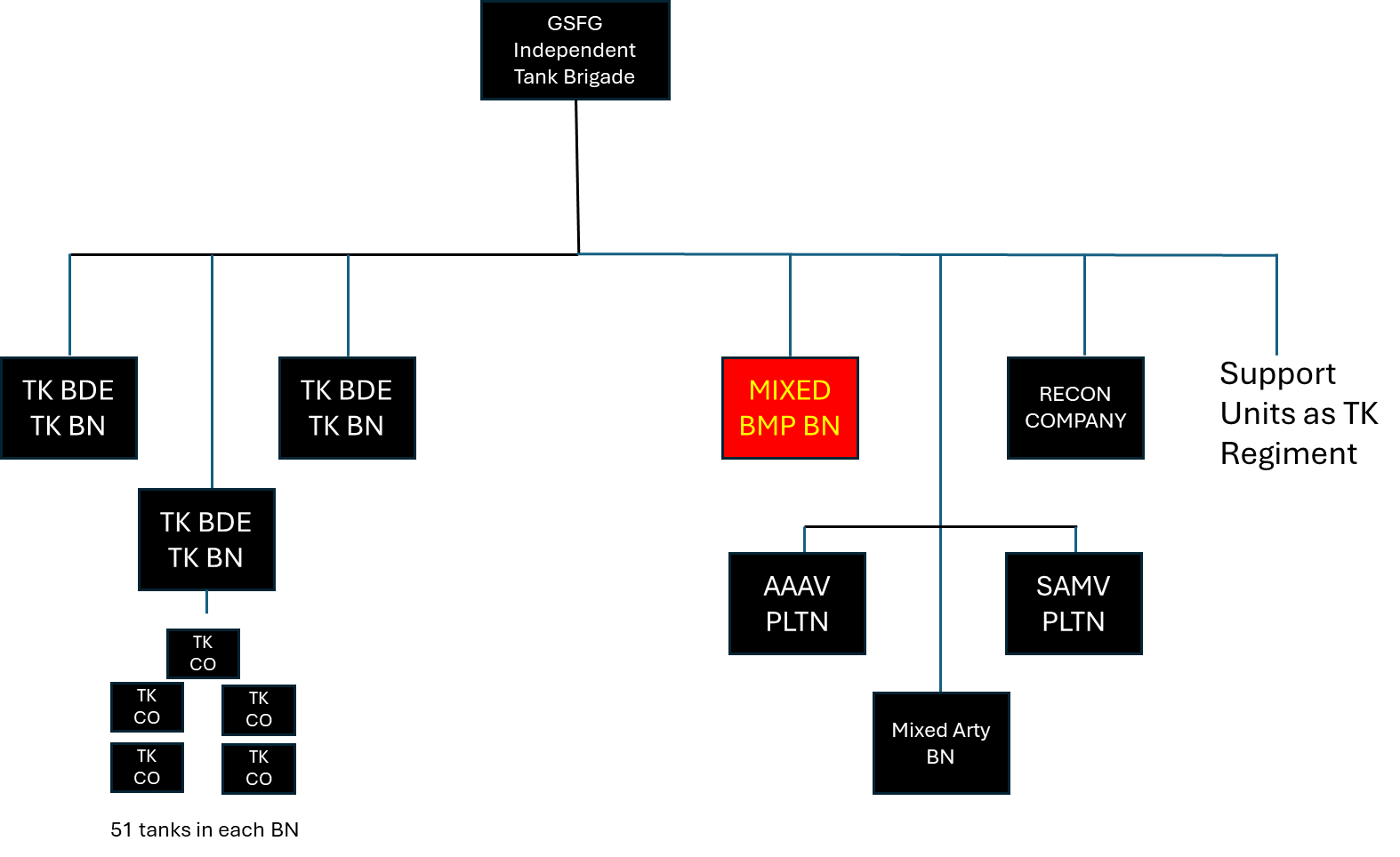
The Tank Brigade TOE (Table of Organization and Equipment) was like the tank regiment, with tank battalions having five companies instead of four, for a total of 154 tanks. Both tank training centers easily met this threshold, and 101st Regiment had two training areas and could easily have fielded a fourth tank battalion. These centers had a mix of self-propelled artillery, likely fielding a mixed battalion. Again BMPs would provide the transport, although the riflemen would come from reserve units activating in the USSR.
While T55s seem odd in this role, remember the OMG’s purpose was a quick penetration of the NATO MLR and exploitation into the logistics areas. The T55 was easily a match for the equally old M48s that populated the West German Heimatschutzkommando brigades charged with Rear Area Combat Operations (RACO). Any tank – including the airborne ASU-85 – was deadly to the logistics units targeted by the OMG. And T55 fuel requirements were significantly lower than T64 or T80.
These units would have a high proportion of experienced praporschik (warrant officers) to command platoons thus being better able to operate independently. If the GSFG transitioned to war maintaining this proportion, these units could also qualify as ‘elite.’
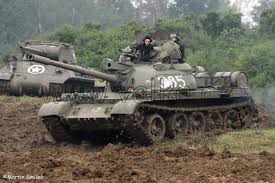
Combined (Unified) Army Corps
In 1980 the Soviets began experimenting with a new formation, variously called the Combined or Unified Army Corps. This was a revival of the Soviet mechanized corps of World War II, not a Corps in either the Western sense or the Soviet usage (Soviet corps of the late Cold War were multidivisional territorial commands directly subordinate to a military district, and usually found protecting the external borders. They lacked most of the support services normally found in a combined arms army).
Three divisions initially participated in this experiment – the 24th (Iron) Motor Rifle Division (MRD) at Lvov, the 120th (Rogachev Guards) Guards MRD at Minsk, and the 5th Guards (Don-Budapest) Tank Division (TKD) at Kyakhta.
In 1982 STAVKA authorized the 120th Guards MRD and the 5th Guards TKD to proceed with the next phase of the experiment. The 24th MRD was frozen. Western intelligence theorized that this was because the Soviets couldn’t afford the attack helicopter and air assault regiments demanded by the new TOE.
120th Guards MRD now became the 5th Combined Army Corps (CAC). 5th Guards TKD became the 48th Guards CAC. The organization developed through 1983. The CIA reported that the new organization was four brigades of five battalions each. Figure 3 shows the Corps organization around 1985.
The brigades had an organic BM-21 rocket artillery battalion, doubled the size of their air defense company and later added a battery of eight SA-8 Geckos changing the ADA unit into a battalion. The Corps air defense regiment eventually had five batteries of SA-11 Gadfly. The Corps had a BM-27 battalion in addition to ‘divisional’ BM-21s. The Artillery Regiment expanded to three 2S3 Acacia battalions.
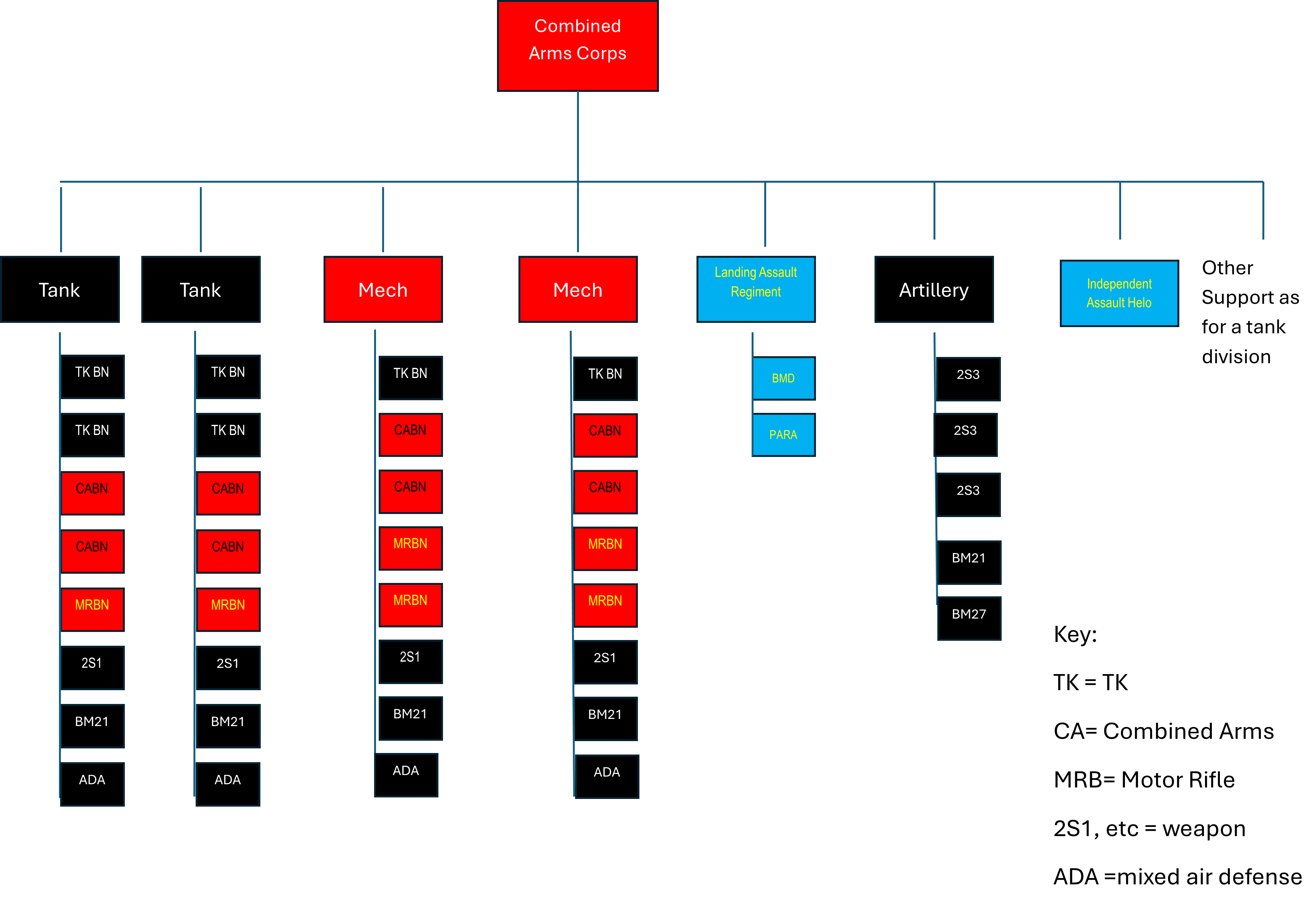
The other unusual feature of these units was the Combined Arms Battalion (CAB). There were at least two in each brigade. Originally, two tank and one motor rifle battalion completed a Tank Brigade, and the companion Mechanized Brigade added one tank and two motor rifle battalions.
Both Corps had organic air assault capabilities, with a Landing Assault Regiment (including a BMD battalion) and an Independent Assault Helicopter Regiment.
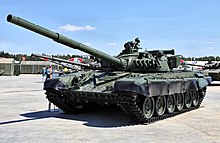
The number of CABs and subunit organization varied between the two Corps and from year to year. The baseline CAB appears to have been two tank companies and two motor rifle companies, but at times there were as many as five companies with Tank CAB having 3 tank companies plus 2 motor rifle companies and Mechanized CAB having the reverse.
The baseline organization would have 462 tanks and up to 566 BMPs, 45 BMDs, 72 2S1, 54 2S3, 90 BM21s, 18 BM-27s, 32+ ZSU-23 or Tunguska, 32+ SA-13, 32 SA-8, and 20 SA-11. As the organization fluctuated, the tank strength approached 500 tanks.
One feature of this experiment was NATO-style task forces combining tanks and BMPs on a habitual basis, to the extent of putting them in the same motor pool. Training exceeded the norms for the regular forces.
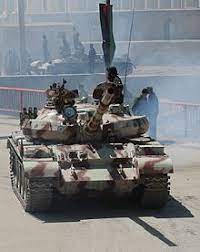
Initially the 5th CAC fielded T72s and the 48th CACs fielded T62s. As experimental units they had first call on newer equipment (T72B and T62M) and trained intensively.
The Soviets started the experiment with other units (notably 32nd Guards TKD and 90th Guards TKD) but they did not get as far as 24th MRD.
Next article will cover the ways to represent these units in Team Yankee.

Still odd that BF don’t allow 13 tank strong Tank Coys for MRDs .
I think that initially BF got seduced by old manuals describing the 1970s organization. Then, having produced the first ruleset and gotten feedback they reasoned that the MRR’s battalion was adequately represented by 3×4 tank ‘companies’ and a battalion HQ. By then the ‘MSU’ meta and the points premium for extra tanks had settled most PACT players on this ‘battalion’ anyway. As a practical matter, in a normal game the only tanks that are affordable as 13-tank are T55A, AM, AM2 and T62/T62M. I can well imagine the NATO player’s reaction to 13 T62M with missiles. But we can still hope.
Just because tank are to high in pts , has never stopped BF putting full coys in the lists . In FOW both Tiger 1 and 2 have lists for a full coys of 14 tanks , that can’t be fielded in “normal” games ( that was V3 , couldn’t say about V4 ).
T80 ROF 1…..It is disappointing a modern tank with veteran skill (shock) and auto loading system to be slower firing than a manual loading NATO tank operated by crew. Even in static. Actually not disappointing but to the fact, ridiculous.
loading is not the only factor in the games ROF. Or in real ROF. Target acquisition (which is easier with four sets of eyes than three) direct digital input from the laser to a digital FCS instead of manual transfer from a readout to the analog FCS etc all affect ROF. And Soviet tanks frequently practiced ‘volley fire’ which further slowed engagements. (shoot the tank on the right, Yuri! My right or your right, Ivan!) and the elephant in the room is stowed load – Soviet tanks carried a lot more HE than most NATO tanks, and thus had less AP/HEAT. To ignore ammo in an eight-turn game, the Soviets have to shoot a lot slower. So IMHO the game is closer to the real world of 1980 than it appears.
The real problem with the Shock Company list is that Battlefront completely overthought the backstory behind it. It really doesn’t need to be that deep.
Just have it so that Nikolai Ogarkov got his way in the WWIII timeline and the Soviet Army started reconfiguring along the Military Technological Revolution, starting with a few high tech company scale forces as a proof of concept – boom, company scale forces loaded with T-80s and BMP-3s that all have a statline that lets them consistently do fun interesting things on the table.
Because really if they’re going to bring experimental equipment into the game, and they did, then why not do the same with experimental combat doctrine?
Basically don’t forget about the Military Technological Revolution is what I’m mostly saying here.
I don’t disagree but RMT as hypothesized by the Soviets worked at the Operational Level, i.e. divisions and Armies and not the tactical level. There are a few tweaks – giving Soviet strike aircraft ‘TOS-like’ capabilities and BM-27 DPICM (counting one shooter as two vehicles) and representing jammed communications by changing reserve rolls and strike aircraft availability by one, prohibiting ambush in LOS of the Soviet spotters etc. I.e., dirt in the game system. Fundamentally I picked the low-hanging fruit – units that could and should be represented in the game with better than standard Soviet skill and NOT driving T80s because they didn’t have them
Oh no argument about adding in more statline variety for Soviet lists – I’ve been preaching that one myself for almost a decade now.
But there are those of us who WANT specifically T-80U tanks and BMP-3s all with really awesome skill stats, and who are also interested in more historical hooks to ground them in, and “They didn’t have T-80s” isn’t exactly the most helpful to that.
So I dunno maybe think about a deep-dive into RMT and the post-Afghanistan small-unit stuff I vaguely remember seeing mentioned somewhere as a possible Part III. I’d pitch one myself but my historical sources are probably a bit too limited to do a really good job with it.